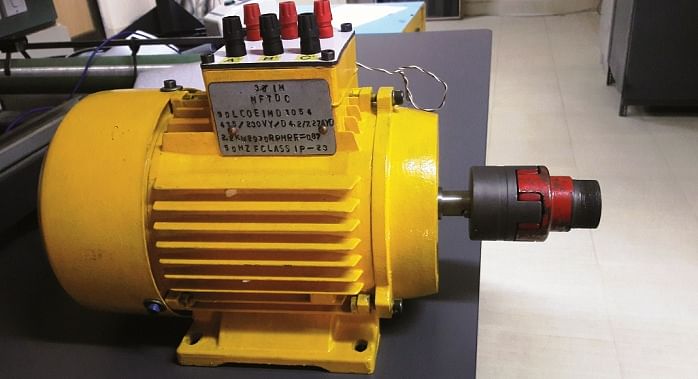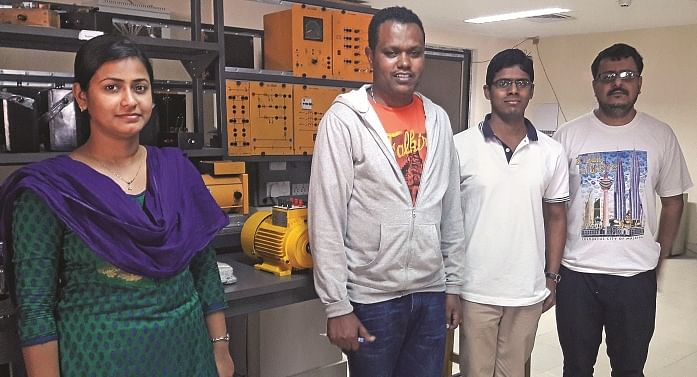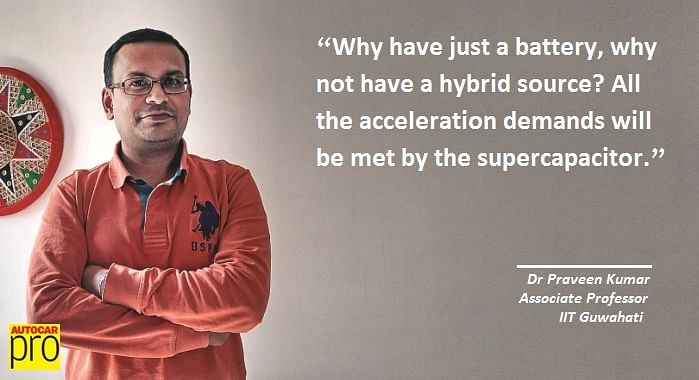IIT Guwahati works on developing indigenous e-mobility solutions
A team of researchers is at work on developing an indigenous electric powertrain. A key focus is to move away from using rare earth elements in motors.
The electric vehicle (EV) industry in India hasn’t reached the critical scale yet, but researchers in a laboratory in one corner of the country are working on projects that could help give a leg up to some EV makers as well as to the Make-In-India drive.
A few hours before our meeting, Dr Praveen Kumar, associate professor at IIT Guwahati, receives an update from a team of researchers who are working under his supervision has managed to reach a weight level of 15.8 kilograms in a motor.
When the project started in September this year, the weight was 26kg. This motor is part of a family of motors, a key component of an electric ‘powertrain’ that the team in IIT Guwahati is working on. More importantly, the team wants to offer a powertrain with magnet-less motors. The main objective behind it is to avoid the dependence on rare earth materials which are usually imported. “We want to show that the induction motor or the synchronous reluctance motor can do the work as good as the permanent magnet motor,” Dr Kumar told Autocar Professional.

The first prototype of a copper cast induction motor.
Other members of the motor family that Dr Kumar and his team of five research scholars at the electronics and electrical engineering (EEE) department of the institute are working on are a copper cast induction motor and a permanent magnet motor. Each type of motor will be available in all the power categories that the team is working on.
The various power categories are – 1kW (for two-wheelers), 3.5 to 5kW (for three-wheelers), 8kW (three-wheeled passenger carriers), 12 to 14kW (for minivans), 20kW (for midsize sedans), 60kW (mini buses) and 120kW (city buses).
IIT Guwahati’s focus on building capabilities in motors is part of the larger goal of being able to design an entire EV powertrain. “The entire powertrain, which includes the machines, controllers and the convertors. Of course, we are not focusing on making batteries because that’s more of chemical engineering, chemistry thing so we can’t handle that. For that we will have to rely on other sources,” says Dr Kumar.
The team has consulted industry players for inputs, in addition to tracking the developments in the global EV industry. Its plan is to complete all designs by December 2017 and “to a large extent” put them in test vehicles. The team isn’t working for any OEM yet, but it plans to invite some of them to showcase the indigenous capabilities in the EV space. “We want to show that there’s no need to import the machines, the controllers. Everything can be done in-house,” says Dr Kumar.
But why would an OEM pick up the EV solution from the IIT lab instead of sourcing it from Tier 1 suppliers backed by decades of experience? Dr Kumar admits he has a disadvantage in this regard, but he also says that IIT Guwahati can offer more value to OEMs when compared to conventional suppliers. “The disadvantage we have now, compared to very well established Tier 1 suppliers is that we don’t have years of knowhow. They can, maybe, design the component or the sub-system. Maybe they can design the motor in a month. But if the OEMs reach us, maybe we will take three months instead of one. But we would need three months for the first time. After that we will cut down the time with every successive design. The difference, when it comes to us, is that we will give a complete design philosophy transfer, not just the design transfer,” says Dr Kumar, who believes that building the know-why is equally, if not more, important as offering know-how to clients. The 42-year-old associate professor may know a thing or two about offering value to automotive clients as he has had a stint in an AVL Group company in Germany before joining IIT Guwahati in 2009.

L-R: Binita Nanda, Tepera K Tolosa, Bikash Sah and Rajendra Kumar are part of the team developing the new solutions.
The current project, aimed at EV applications, was preceded by a project for application in city-buses that uses supercapacitors with contactless charging system. Dr Kumar says it will now require the partnership of city transport authorities to be put in real-world application. Before that happens, there is now an effort to develop a contactless charging system for a scooter.
Dr Kumar and his team earlier developed a system for intra-city buses. Called Purta (Sanskrit for complete), it is a concept of an electric bus with capacitors, instead of batteries, which get charged every time the bus halts at a bus-stop. Supercapacitors were chosen over lithium-ion batteries as such vehicles do not have to travel long distances without refueling opportunities. “We recently got a big pack of lithium ion batteries and will be testing in the actual system. And we are also taking care of the angles at which the scooter or the motorbike stands so that what will be the best efficiency we can achieve because the distance between the two are not always the same,” says Dr Kumar.
Kaizen at work
The works at just one laboratory at IIT Guwahati reflect how researchers and innovators in the academia space are constantly at work to develop new solutions. Not all projects may succeed. But with increasing pace of evolution and competition in the automotive world, such efforts merit to be part of industry-academia collaborations, not only for mutual benefits but also for the growth of India.
Incidentally, we witnessed the opening of the package containing the first prototype of a motor designed by the IIT Guwahati research scholars and made by the Nonferrous Materials Technology Development Centre.
INTERVIEW Dr P Kumar, Associate Professor, IIT Guwahati

Will the development time shrink after the first motor, as it will only be a matter of different sizes then?
More than the sizes, the important thing is to inculcate the design philosophy among people. Once that comes in, then every engineer can do an independent job because they know what are the right questions to ask. The horizon widens.
For the 12.5kW motor, it took us four months. For the next one, which may be a 20kW or a 60kW, the design time will come down to a couple of months. The idea is that if in a month they can design a system, it will be very good.
Is this work done totally independently, or through some alliance?
We have some alliances with the governmental agencies for prototyping because we can’t make it here. Conceptualising, development and designing have been done in-house.
How about supercapacitor-powered two-wheelers?
We are thinking. That’s an idea which came up in one of our discussions about why have just a battery, why not have a hybrid (battery and supercapacitors) source? All the acceleration demands will be met by the supercapacitor, normal driving demands will be met by the battery. That will put less stress on the battery. It will extend the life of the battery and the performance of the vehicle would be better. So, hybridisation of the power sources is a serious thing we are looking into.
Plus, we are now seriously thinking of developing indigenous supercapacitors. The current ones are imported. Our role here in IIT Guwahati will be to balance the individual cells because you need to connect many cells together. The supercapacitor material, all the electrolytes and so on would be developed by another partner agency. We have applied for the project. As soon as the funding comes, the work would begin.
What should the government do to ensure that the incubation is done properly and the derivation of the advantages is done properly and the country benefits? Where are the missing links?
I think the missing links start from pre-school. How many times did you feel that questioning was encouraged? How many times did you feel that independent thinking was encouraged? No, not very often. The teacher writes something on the blackboard and the students copy it. The teacher asks similar thing in the examination, the student is supposed to reproduce. If you go off the track, or if you try to be creative, most of the times you are penalised.
So, fall in line is the motto as of now. It’s in research, education, everywhere. If you look at the Indian philosophy, that was not the case. If you see, it’s all questioning. It’s asking a question. The other person gives a hint to what might be the solution or answer and then leaves it to the listener to choose his/her own way.
What are the key steps that should be taken immediately in industry-academia collaboration?
First of all, the academia should invite industry in curriculum formulation. Take the industry’s opinion. The industry and academia should keep their egos aside and have a frank discussion.
Industry should also be willing to take a risk. If they fund 10 projects, maybe eight would fail. Two would succeed. Let’s try it. A bad solution is clearly an indication that we should not walk down that path. There’s nothing called an absolute failure. Industry should increase its appetite for risk. Here the risks are not very high stake risks. Maybe, if an industry gives a project of Rs 20-30 lakh, even if it fails I don’t think that it is a serious drain on their balance sheets. But out of 10 projects of Rs 40-50 lakh each, even if two succeed then the benefits will outweigh the losses any day.
This story was first published in Autocar Professional's 12th Anniversary issue. Subscribe to our magazine to get exclusive news, features and analysis.
RELATED ARTICLES
Tata Motors: From Ice Legacy To Electric Intelligence
Tata Motors has a lot riding on the newly launched Harrier EV, coming as it does on a fresh, EV-oriented software platfo...
Complete List of Cars and SUVs Tested by Bharat NCAP
Bharat NCAP has crash-tested 20 models to date, including both ICE-powered vehicles and EVs.
Belrise Industries: A Story of Grit and Focus
The Belrise Industries IPO is the culmination of a multi-decade journey by entrepreneur Shrikant Badve that started in a...





 By Sumantra B Barooah
By Sumantra B Barooah
 16 Jan 2017
16 Jan 2017
 45985 Views
45985 Views





 Ketan Thakkar
Ketan Thakkar



 Shahkar Abidi
Shahkar Abidi

